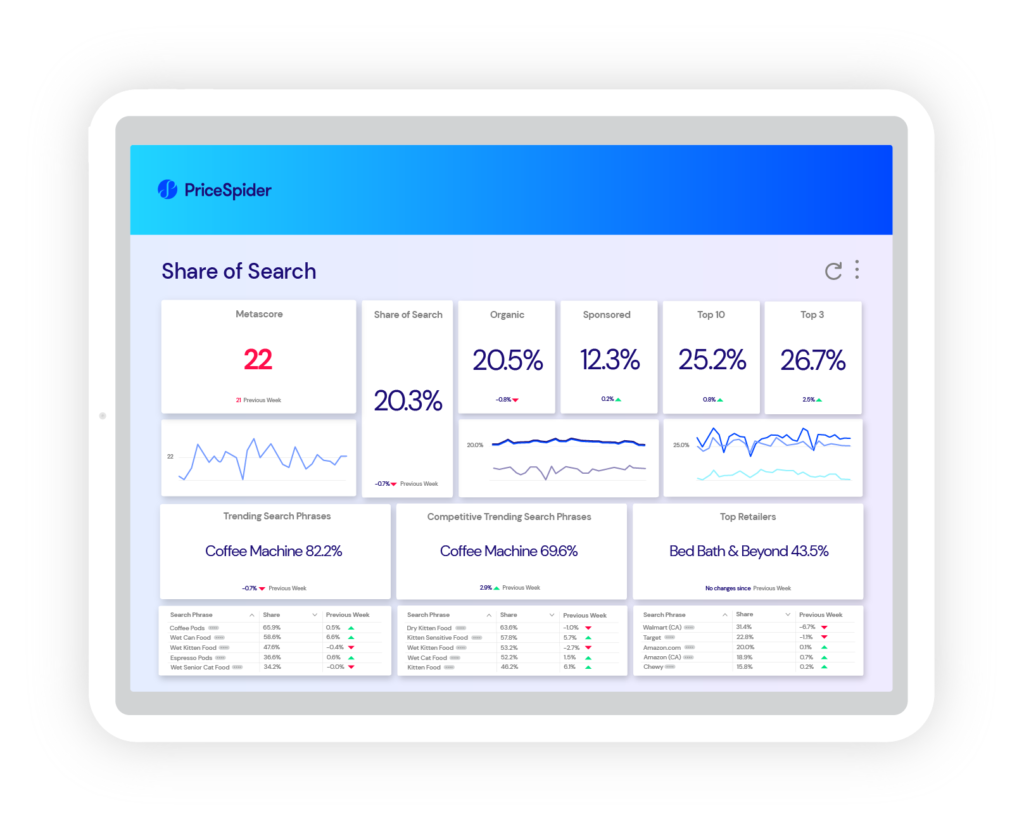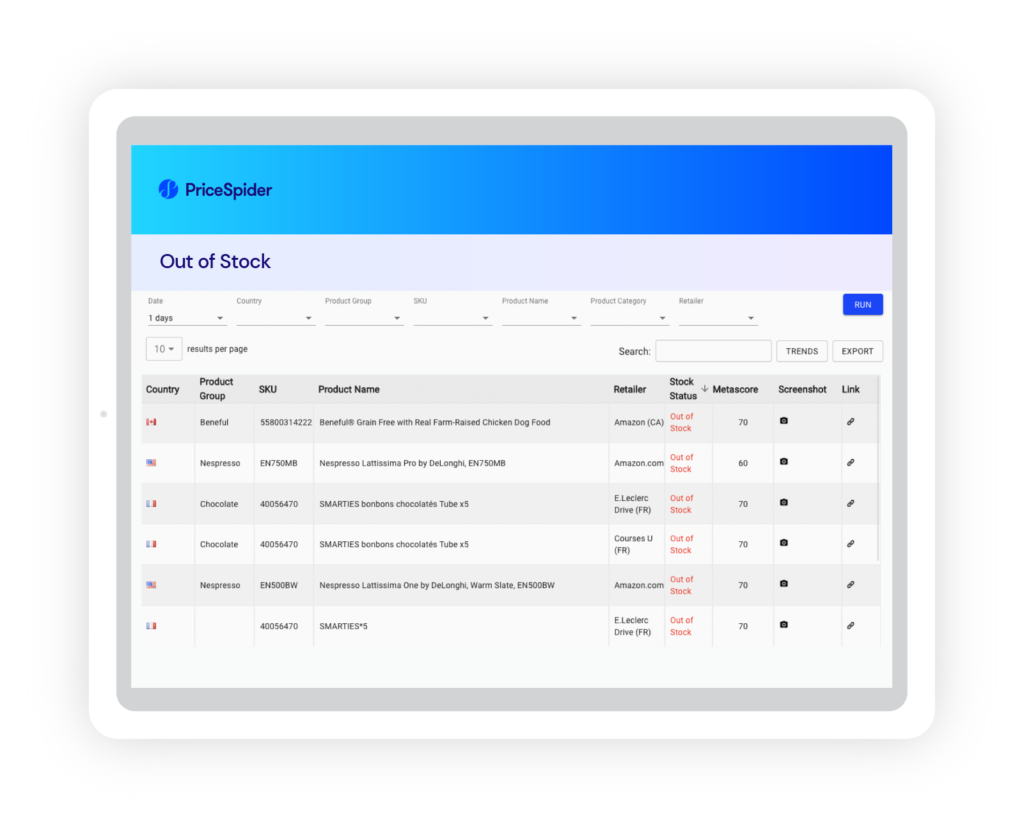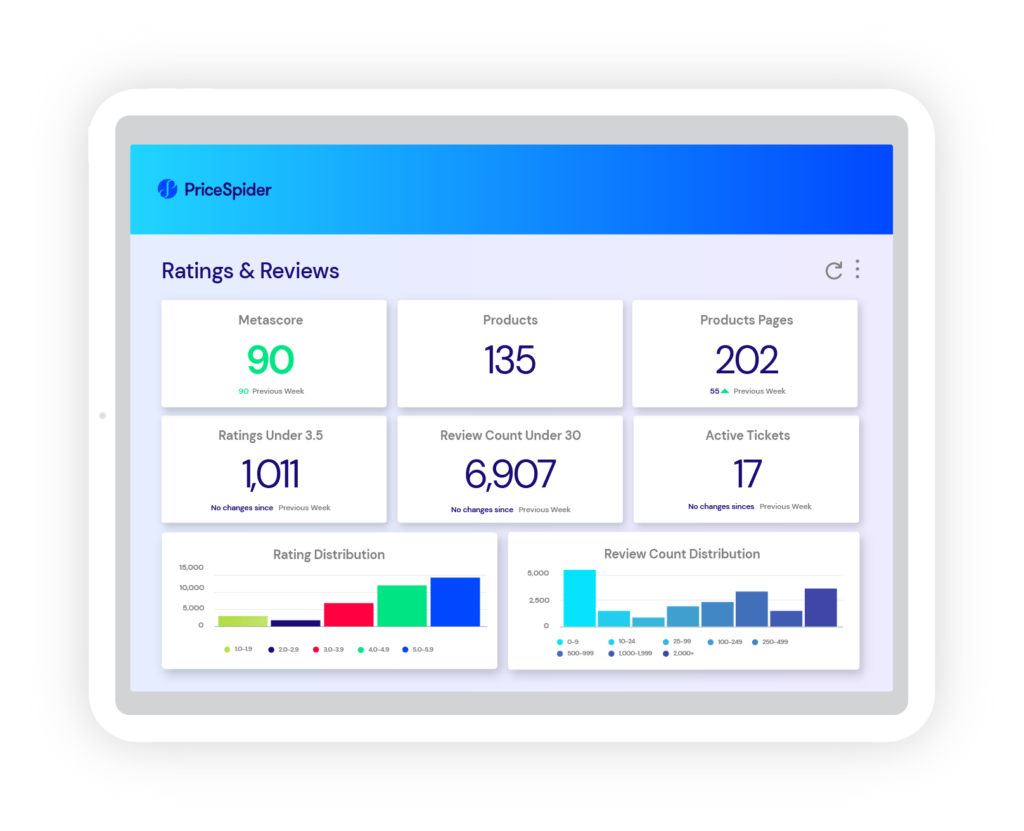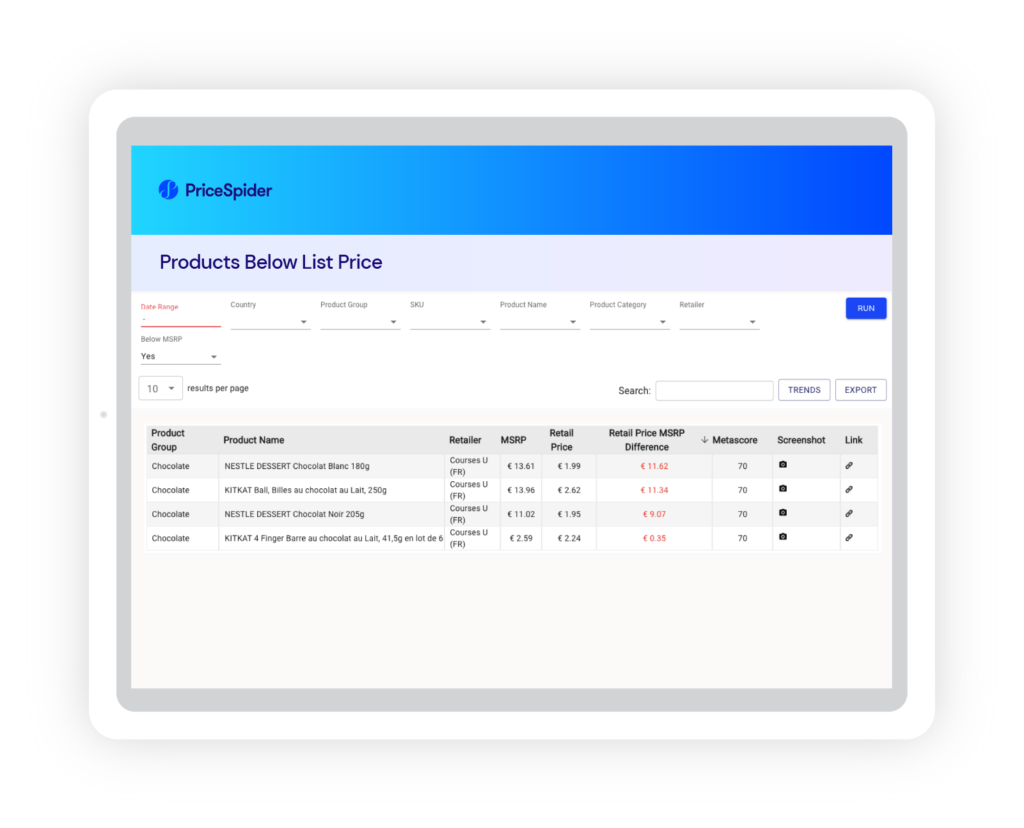You probably wouldn’t want to buy a smartphone that doesn’t take pictures. Or a video game console without controllers. Or a car without a steering wheel. That’s why we watch the keynotes, read the reviews, and go on test drives before we make these major purchases. The same applies to the software we use for our jobs. What good is a word processor without a return key? How useful is a spreadsheet application without rows? Is digital shelf software worth it without content monitoring?
Unfortunately, ecommerce brands that partner with third-party sellers are often in the dark about what’s actually happening on the digital shelf. Retailers don’t give your product pages the time and attention they deserve. They also don’t give you the data you need to improve your performance.
That’s where digital shelf software comes in. This insightful technology helps brands analyze the digital shelf for themselves, exposing potential weaknesses and capitalizing on timely opportunities. It allows them to collect data from retail websites independently without relying on a seller to relay crucial information.
The value of these insights ultimately depends on the specific software’s capabilities. Digital shelf software is still relatively new, and many vendors position their tools as digital shelf analytics solutions when they only have a very narrow set of capabilities.
Digital shelf software isn’t simply a different way of describing established software categories like repricing software. This is an entirely new type of platform, purpose-built for ecommerce brands, particularly those with multiple distributors.
If you want actionable data to monitor, analyze, and optimize the digital shelf, you need digital shelf software with specific capabilities. Here are the top 10 features you should look for.
1. Search position tracking
When it comes to digital shelf performance, few factors have a bigger impact than your position in search results. In a brick-and-mortar store, consumers navigate the aisles to find the section they want to browse and then compare the products on the shelf. On retail websites, search engines facilitate this process, helping customers find the groupings of products that best match what they’re looking for.
If your products aren’t prominently displayed in the results, it’s like they don’t exist.
You can’t spend all day typing in 20 search queries for each of your products on every website you sell through. Even if you did, you’d have to do so daily to monitor how your position is changing, diagnose problems, and recognize opportunities.
A quality digital shelf software solution includes a feature that tracks your products’ rankings for relevant terms across all retail sites you sell on. PriceSpider’s digital shelf software, Brand Monitor, does this with its Share of Search feature. Share of Search tells you when your products rank on the first page, the top 10 results, and the top three results for each term, as well as which of these results come from organic or sponsored search. Over time, you gain valuable insights into how and when your placement changed, so you can see the impact of product page updates, competitor changes, or a batch of stellar ratings.

Additionally with Share of Search, you can apply the same tracking capabilities to your competitors. You can even see which terms they’re paying to appear for, which might help you decide where to direct your ad spend.
2. Text monitoring
Product page copy can make or break your success. Choose the perfect title, add a persuasive description, and include all the specs, and you’re on your way to winning the digital shelf. Let typos, poor grammar, and lackluster copy slip through the cracks, and you may find yourself on page 20 of the results for your product category. (Not to mention, your conversion rates will tank.)
Product page copy has a massive effect on whether customers even see your page. It also impacts how they feel if they get there. You know this. That’s why you work so hard to optimize your titles, descriptions, and supporting paragraphs based on the categories and terms you want to rank for.
After you put in all that hard work, it’s vital that your copy is consistent across every sales channel. Outdated product page copy can mislead customers. It can also underperform or change people’s perception of your brand.
Digital shelf software allows you to put your best foot forward every time by monitoring the text that appears on your product pages. By comparing each page against a template you provide, the software identifies all discrepancies, flagging variations and giving each seller a compliance score.
You wouldn’t want an employee to sink a bottomless pit of time into manually examining every page for every SKU on every retailer’s site. Top digital shelf software gives you content monitoring capabilities so you don’t have to worry about variations hurting your brand integrity or misleading customers.
3. Image monitoring
When a digital shelf solution says it monitors content, don’t assume it’s checking your product pages for images and videos too. Image recognition is a more advanced capability most solutions lack, but it’s important for all the same reasons as text monitoring. An outdated image can mislead customers just as badly as, if not worse than, outdated copy.
Brand Monitor ensures that all your product page assets are up-to-date and in the correct position. Outdated images are flagged in the same place as outdated copy, so it’s easy to see when sellers are out of compliance with your brand guidelines and take your next steps.
4. Stock availability tracking
Imagine customers walking into a brick-and-mortar store. They find the shelf your products are supposed to be on, but it’s empty. Your product is out-of-stock. What are their options? They could go shop somewhere else. They could come back later. Or they might grab the next best option that is in stock.
Online shopping is the same. When your products are out-of-stock, potential customers are faced with these same choices. Most importantly, they can’t buy your product on this website. A lot of brands waste money paying for sponsored ads when their products are out-of-stock. With good digital shelf software, you can do better than a lot of brands.
The moment a product goes out-of-stock on a retailer’s site, Brand Monitor alerts you so that you can turn off your ad spend until it’s back in stock.

But wait, there’s more. When your competitors are out-of-stock, it’s the perfect time to strike. Since people can’t buy their product, you can advertise on their branded search terms, such as their brand name plus the product category, or their product name. As their would-be customers look for other options, your product will conveniently appear as the first available alternative.
5. Ratings and reviews analysis
You can check your ratings and comb through reviews any time. But it’s incredibly tedious for every SKU and every site. Without digital shelf software, you might not notice that your ratings at BestBuy.com took a nosedive last week. Or, that everyone is talking about a use case that never occurred to you before.
With Brand Monitor, you can examine your ratings and reviews from a variety of angles. Check in on each SKU’s aggregate ratings and reviews across all sites or zoom in on ratings from a specific point in time.

You can also see what phrases are coming up the most in your reviews. With this information, you can incorporate these hot phrases into your copy, discover new ways people are using or thinking about your products, or identify consistent problems you need to address.
Best of all, you can perform this analysis on your competitors. Learn what their customers love most, where they’re failing, and how their quarterly ratings stack up against yours.
6. Price monitoring
Price is one of the biggest factors that influences a consumer’s decision to buy. It’s also one of the hardest things for brands to keep in compliance with their guidelines. Simply having a minimum advertised pricing (MAP) policy isn’t enough to ensure your sellers honor your lowest price. You have to watch them or else they’ll slash prices to gain an unfair competitive advantage.
Without price monitoring, you can’t enforce your MAP policy. Without enforcement, your policy may as well not exist. If sellers realize that you aren’t paying attention, the worst offenders will constantly violate your policy.
Sadly, the only way for your best retail partners to compete with these sellers is to do the same. In fact, many sellers use repricing software to automatically lower their price in response to price drops. Over time, this erodes the value of your products and fractures your brand integrity.
As with most of the digital shelf, it’s simply unrealistic to monitor prices on every product on every site. Prices can change so fast, even brands with small catalogs are bound to miss pricing policy violations. Thankfully, this is another area where digital shelf software shines.
Brand Monitor tracks your pricing 24/7, notifying you any time a seller violates your policy. Catching violators and following up with them is crucial for maintaining your brand’s health on the digital shelf.

7. Real-time crawling
Ecommerce is fast-paced. Opportunities come and go quickly. Problems can hit your brand at a moment’s notice. If your digital shelf software collects data slowly or infrequently, it’s going to be a lot less helpful. A lot of ecommerce tools claim to give you data in “real time,” but few actually deliver. It’s important to clarify what a vendor really means when it says this, and to investigate how it collects data.
Often, ecommerce software pulls data a fixed number of times per day, sometimes at predictable intervals. Some tools only pull data on particular days. There are a few ways in which lacking real-time data puts you at a major disadvantage.
Imagine getting an out-of-stock alert hours, even days, after a product went out-of-stock. By the time you react and reallocate your ad spend, the opportunity is probably gone!
How about price monitoring? Not only do you need to catch pricing policy violations early to prevent other sellers from following suit, but you also need to know who moved first. The sellers who violate your policy first are the biggest culprits and need steeper consequences. Not to mention, with repricing software, sellers can schedule pricing changes to happen “in the gaps” when your software won’t detect them.
Brand Monitor is built on our proprietary “spidering” technology. It crawls thousands of retail sites just like a customer would, watching them in real time to always give you data that is current.
8. Global tracking
Your tools aren’t much use if they can’t track your products on the websites you actually use. Most vendors boast that their digital shelf software crawls every site your products appear on, but they’re heavily weighted toward local markets. If you do a lot of business overseas, you better make sure the solution you choose tracks ecommerce activity on the retailer sites you need. If they don’t have the integration you need now, you may have to wait around a while before they can develop it.
Our digital shelf software tracks SKUs on over 2,000 retail sites and more than 20 online marketplaces, including the biggest sites in more than 90 countries. And we’re always adding more integrations.
9. Intuitive dashboard
All the data in the world isn’t much good if it’s hard to access and clunky to navigate. Invest in tools your employees can actually use. You also don’t want to have to call tech support every time you want to perform a basic function. If you’re shopping for digital shelf software, make sure you see what it looks like, with particular attention to the dashboards.
Want to see how Brand Monitor looks? Schedule a demo with a PriceSpider expert today.
10. Date range filters
Over the years, product pages accumulate a lot of ratings and reviews. Your position in search results goes up and down. Stock comes and goes. Seeing aggregate data and real-time information is certainly helpful, but if you want to take a deeper dive into the digital shelf, you need tools that let you explore data during specific date ranges.
How were your ratings last month? Last quarter? Last year? Have sentiments changed in your reviews? How often do your products go out-of-stock in a given quarter? When you rolled out that product page update six months ago, did it have any impact on your position in search results? These are questions you can answer only with digital shelf software that lets you filter data by date range.
Choose a vendor you can trust
Software is only as good as the vendor that produces it. Once you’ve found a solution with the capabilities you need, make sure to vet the company behind it too. Do other brands use them? Do they have the infrastructure to support their software at the scale you need? How is their technical support? How is their onboarding process?
PriceSpider has developed purpose-built ecommerce software for 20 years. More than 2,000 brands rely on our tools around the world, including leading brands you know, like P&G, Samsung, Mattel, GE, Sony, Unilever, Nintendo, and Sony.
Want to see for yourself why so many brands turn to PriceSpider?
Schedule a demo of Brand Monitor today.

